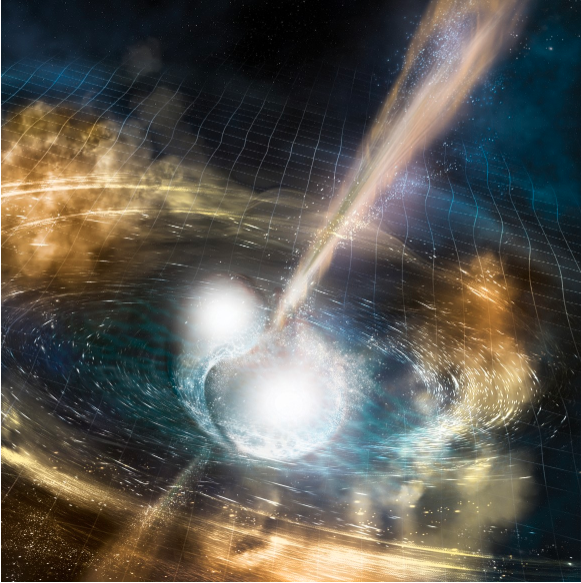Gravitational waves detected from colliding stars for the first time

100 million years ago two super-dense neutron stars violently merged into one, sending out a burst of radiation and gravitational waves, ripples in space and time, that have been travelling through the Universe ever since.
Now, in a first, an international team which includes researchers from the University of Melbourne has detected this stellar collision as gravitational waves, and also observed it as a ‘fireball’ of electromagnetic waves.
Professor Andrew Melatos, who leads a team of gravitational wave researchers in the School of Physics at the University of Melbourne, said the event marks the dawn of a new era in astronomy that promises to revolutionise our understanding of the Universe.
Professor Melatos and his team belong to the Laser Interferometer Gravitational Wave Observatory (LIGO) Scientific Collaboration, a large international project dedicated to gravitational wave discovery.
They are also members of the Australian Research Council Centre of Excellence for Gravitational Wave Discovery (OzGrav).
In 2015, LIGO made the first direct detection of gravitational waves from the merger of a pair of black holes, interpreted as something akin to an ancient “sound bite”.
This result confirmed Einstein’s prediction a century earlier and earned the 2017 Nobel Prize in Physics.
But black hole mergers don’t seem to emit electromagnetic radiation – at least, not the ones detected so far. Neutron stars, in contrast, shine brightly in visible light and gamma-rays.
“Now, for the first time we have colourful electromagnetic waves to accompany the gravitational wave ‘chirp' music, bringing us a beautiful picture encoded with tons of secrets from the Universe,” said Ms Lilli Sun, a PhD student whose research focuses on analysing data from LIGO.
“When I saw the results come through that morning, it was a dream come true.”
Another PhD student working on the LIGO project Patrick Clearwater said: “Neutron stars mergers are among the most energetic events in the Universe, surpassed only by merging black holes.
“By simultaneously analysing the gravitational and electromagnetic signals, we can learn so much more about these fascinating explosions.”
The University of Melbourne has been part of LIGO since 2007, contributing to the project’s data analysis program.
As well as bursts, Einstein’s theory predicts that gravitational wave signals can take other forms, including continuous tones, like the note of a flute that plays forever.
“One of our dreams is to hear the song of an individual neutron star spinning rapidly,” Professor Melatos said.
“As soon as we learned that a pair of neutron stars had merged – possibly combining to form a single, fast-spinning remnant – we sprang into action to hunt for it in the data.”
The ongoing hunt for the post-merger remnant is a team effort in collaboration with LIGO colleagues Drs Paul Lasky and Eric Thrane, based at Monash University.
Searching for gravitational waves is one of the most challenging measurements humanity has ever attempted. Even with the exquisite sensitivity of LIGO, researchers need to develop ingenious algorithms running on supercomputers to dig out tiny signals from the noise.
The University of Melbourne effort leverages an algorithm which is widely used in practical engineering applications like mobile telephony.
Researchers in the University of Melbourne’s Department of Electrical and Electronic Engineering joined the team to optimise the algorithm.
“They taught us cutting-edge methods to improve the search, to the point where it is nearly ten times more sensitive and one hundred times faster than when we started,” Ms Sun said.
Gravitational waves are not absorbed by matter. They pass right through the Earth for example, so they let us “image” the extreme matter inside a neutron star without obscuration.
"Neutron stars resemble gigantic atomic nuclei, filled with swarms of subatomic particles packed together as tightly as nature allows,” Professor Melatos said.
“Humanity can’t manufacture subatomic matter in bulk, so observing neutron star collisions with LIGO is a great way to study its properties and answer some of the deepest questions in physics", Professor Melatos said.
“Nature has gifted us a wonderful new tool. We can’t wait to use it!”